We recently compared three single-action revolvers from Colt and Traditions chambered in 45 ACP or 45 Colt, also called 45 Long Colt. The two Colts are genuine factory-branded wheelguns, and the third is a modern Italian-made clone from Pietta, branded by Traditions Firearms. The Colts are not exactly the guns that won the West, and we are glad they are not. Well made of modern steel, they are good performers, but so is the Traditions revolver for a lot less money. The Traditions 1873 Frontier is a credible clone of the Colt 1873, with an improved action that allows carrying the handgun fully loaded with six cartridges.
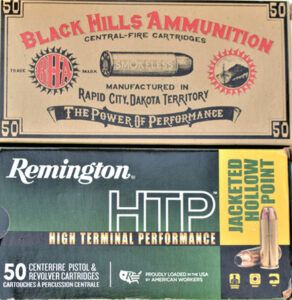
We based the test on the suitability of the revolvers for all-round use. This might mean Cowboy Action shooting, as a hunter’s backup handgun, for protection against wild beasts, and even home defense. We believe that most of these revolvers are used for recreation because they are fun shooters. But even a fun gun with no serious niche in the scheme of things should not be aggravating to use and fire and should fire to the point of aim, be smooth in operation, and provide the user their money’s worth. In this case, we found two handguns that met those criteria, and one that did not, in our estimation.
We wanted to learn what type of accuracy and performance you could expect from these revolvers. Protection against wild beasts, including feral dogs and the big cats, was part of the assessment. Would you be helpless with a modern single-action revolver in such a situation? Far from it. We also wanted to determine just how wide a spread there is in performance between low-cost and high-cost versions. As it turned out, there’s very little separation, and the difference may not be discernible except by the most experienced shooters. Here’s how they shook out:
Gun Tests Grade: B
$1900
The Wiley Clapp Single Action Army illustrated is a special version offered by Talo Distributors some years ago, and reasonable samples may still be found as new-in-box handguns or in the gently-used market. The Wiley Clapp revolver was originally advertised as being designed for a shooter by a shooter, with Clapp being a well-known (for many) gun writer. Just the same, many of these handguns, perhaps even most, are advertised for sale in unfired condition, just as this revolver was.
| Action Type | Revolver, single action, hammer fired |
| Overall length | 10.25 in. |
| Overall Height | 5.5 in. |
| Cylinder | 6 rounds, fluted |
| Weight Unloaded | 37.0 oz. |
| Weight Loaded | 40.0 oz. |
| Barrel Length | 4.75 in. |
| Maximum Width | 1.6 in. |
| Frame | Steel |
| Front Strap Height | 2.1 in. |
| Back Strap Height | 3.4 in. |
| Grips | Wood, dragon scale |
| Grip Thickness (Maximum) | 1.63 in. |
| Grip Circumference (Maximum) | 6.0 in. |
| Front Sight | Fixed blade |
| Rear Sight | U-notch cylinder groove |
| Sight Radius | 5.75 in. |
| Trigger Pull Weight | 3.0 lbs. |
| Safety | No manual safety |
| Warranty | 1 year |
| Telephone | (800) 962-2658 |
| Website | Colt.com |
| Made In | USA |
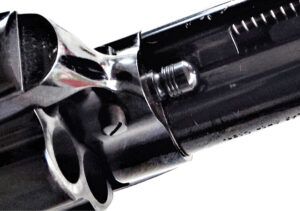
The Wiley Clapp revolver doesn’t feature a casehardened receiver, but instead has a nice rich blue finish. The wood grips feature a dragon-scale type texture with the Colt emblem prominently displayed. The sights are typical single-action fixed-sight revolver sights, a fixed front half moon blade and a groove in the top of the frame. When firing at silhouette targets quickly, we often used only the front sight, holding it a little high over the rear sight and low on the target, firing at the lower part of the target to send bullets into the X ring. The fit of the grips to the grip frame is flawless, very well done. The 4.75-inch SAA barrel is often called the gunfighter’s barrel length, as opposed to the artillery model with its 7.5-inch barrel.
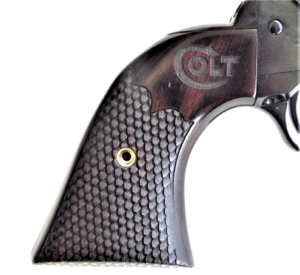
The primary difference in this and many other single-action revolvers is the chambering, 45 ACP. Based on economy, accuracy, and performance, this is a good choice. Ammunition is plentiful in diverse loadings, from light target loads to heavy defense loads. This is a button-ejecting revolver, and the ejector rod simply contacts the inside base of the cartridge, so cartridge length isn’t a consideration. In fact, the Wiley Clapp revolver was the easiest to quickly unload. Cases simply fell out of the highly polished cylinder when the loading gate was opened and the cylinder rotated as the barrel is pointed skyward. Loading required attention to detail with the shorter cartridges, but there was no speed deficit after a bit of practice.
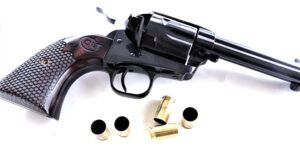
Our experience with 45 ACP revolvers indicates they are not often among the most accurate wheelguns. The long jump of the bullet down the chamber and into the barrel throat sometimes results in less-than-stellar accuracy. The short bullet may tip in its travel from the chamber into the bore, according to our handloading expert. Further, full-metal-jacket (FMJ) bullets are less accurate than lead semi-wadcutter (SWC) bullets because the latter’s longer bearing surface rights the bullet in the bore, as our testing illustrated. Because most shooters do not reload, some experimentation with commercial loads may be needed to experience good accuracy.
This revolver was unfired in the box with the original papers and demanded a high price. Of course, it did not remain in such condition long. For the Gun Tests team, firearms are meant to be used. Good news then because this revolver isn’t a rarity but is instead a modern production revolver, so we fired it extensively.
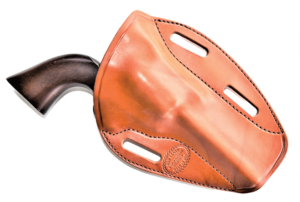
The holster makes a great deal of difference in drawing speed and wearing comfort with the SAA. We used a Simply Rugged Sourdough holster for much of the work. ($80 for the base holster from SimplyRugged.com) This is a versatile holster we used in both strong-side and crossdraw carry. From Jeffrey Custom Leather, we used the Ranger, a high-ride holster useful for all day carry and field use as well as concealed carry ($155 base from JeffreyCustomLeather.com). The Traditions Slim Jim ($34 from OldSouthFirearms.com) is an economy holster that worked fine for casual use. Much of the shooting began from crossdraw, which was fine because the raters followed the rule of one on the firing line crossdrawing and one to the right not crossdrawing. The Wiley Clapp revolver was the smoothest from the holster, we thought.
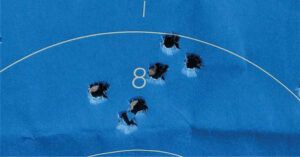
The hammer is easily cocked to the full-cock position. The typical four-position Colt hammer and its indents were distinct. Trigger compression is a crisp 3 pounds, making it the best of the test. We elected to use three loads to test the Colt — a practice load, a standard load, and a maximum load. Most of the firing was done with the Black Hills Ammunition 200-grain lead semi-wadcutter. We also used handloads using the MattsBullets.com 260-grain SWC over enough Titegroup powder for 800 fps. Finally, we fired the Buffalo Bore 255-grain Outdoorsman load. During the initial test, our shooters fired the revolver at man-sized targets at 5, 7, and 10 yards. We learned the sights were well regulated, striking to the point of aim with the 260-grain handload. However, during the initial firing, the screw holding the ejector rod worked out and the ejector rod took flight. This put a halt to the test. This occurred at fewer than 100 rounds. We were able to find the ejector-rod housing, ejector, and ejector spring. The tiny ejector-rod screw was never found amid a backdrop of gravel, dirt, sand, and spent cases. The piece was definitely unfired in the box. It must have left the factory with a loose screw. We could not locate a Colt ejector screw for sale, but we had a Pietta Traditions revolver on hand, and the screw from the Pietta fit the WC Colt perfectly. So, we ordered a Pietta ejector-housing screw. With shipping, the total was $18.

Otherwise, the revolver was a joy to shoot for those who enjoy single-action revolvers. Firing the 200- and 230-grain loads, recoil was modest and practical accuracy good. The revolver handles well. The Colt Wiley Clapp’s action allowed for rapid results, for a single action. Firing from a solid bench rest we used three loads for accuracy. These were the Black Hills 200-grain LSWC, Fiocchi 230-grain JHP, and the Buffalo Bore 255-grain SWC. The revolver grouped five shots into 1.8 inches at 25 yards for the best effort with the 200-grain SWC. Not surprisingly, the Buffalo Bore load exhibited a consistent 1025 fps in velocity. This is a hard-hitter well suited to defense against animals in the wild. Muzzle flip was substantially increased with this load, and it struck 3 inches above the point of aim. The Wiley Clapp revolver is an accurate handgun. The best groups were the best of the test.
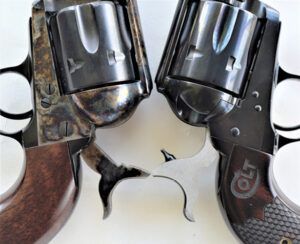
As a side note, never fire 45 ACP shotshells in the 45 ACP revolver. They blossom the cartridge case forward due to their design and will result in a locked-up revolver, as the owner of the Wiley Clapp learned. Some effort with a small punch was needed to budge the cartridge case forward and unlock the revolver.
When we disassembled the Colt Wiley Clapp revolver for cleaning, the cylinder retaining pin was difficult to remove, requiring a special tool and tapping with a padded hammer. It hasn’t loosened up after considerable firing. Compared to the other revolvers, the Colt Wiley Clapp revolver is more accurate and the action is smoother, much smoother than the other Colt.
The Colt Wiley Clapp is chambered in 45 ACP, and there seems to be no drawback in using a 45 ACP single action. Jacketed-hollowpoint load performance is comparable between the 45 ACP and 45 Colt. In the maximum loads from Buffalo Bore, the 45 ACP load at 1025 fps and intended for outdoors use exceeded the 45 Colt load at 939 fps.
Our Team Said: In the end, we rated the Colt Wiley Clapp down a grade on the very tight base pin, which made cleaning difficult. As for as accuracy and smoothness, this revolver is a good example of a fine single-action revolver.
Range Data
| Colt Wiley Clapp Single Action Army 45 ACP | Black Hills 200-grain LSWC | Handload 260-grain SWC | Buffalo Bore 255-grain SWC |
| Average Velocity | 875 fps | 848 fps | 1025 fps |
| Muzzle Energy | 340 ft.-lbs. | 415 ft.-lbs. | 595 ft.-lbs. |
| Small group | 1.8 in. | 2.5 in. | 2.0 in. |
| Average Group | 2.4 in. | 2.9 in. | 2.5 in. |
| Colt Single Action Army P1840 45 Colt | Remington 230-grain JHP | Black Hills 250-grain LRN | Buffalo Bore 255-grain SWC |
| Average Velocity | 922 fps | 749 fps | 939 fps |
| Muzzle Energy | 434 ft.-lbs. | 311 ft.-lbs. | 499 ft.-lbs. |
| Small Group | 2.4 in. | 2.5 in. | 2.9 in. |
| Average Group | 3.0 in. | 3.2 in. | 3.5 in. |
| Traditions 1873 Frontier SAT73-002 45 Colt | Remington 230-grain JHP | Black Hills 250-grain LRN | Buffalo Bore 255-grain SWC |
| Average Velocity | 940 fps | 735 fps | 952 fps |
| Muzzle Energy | 451 ft.-lbs. | 300 ft.-lbs. | 513 ft.-lbs. |
| Small Group | 1.9 in. | 2.0 in. | 2.3 in. |
| Average Group | 2.3 in. | 2.3 in. | 2.9 in. |


























